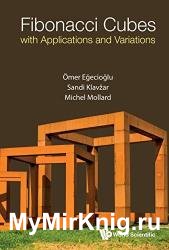 Название: Fibonacci Cubes with Applications and Variations Название: Fibonacci Cubes with Applications and Variations
Автор: Omer Egecioglu, Sandi Klavzar, Michel Mollard
Издательство: World Scientific Publishing
Год: 2023
Страниц: 303
Язык: английский
Формат: pdf (true)
Размер: 14.6 MB
Fibonacci Cubes have been an extremely popular area of research since the 1990s.
This unique compendium features the state of research into Fibonacci Cubes. It expands the knowledge in graph theoretic and combinatorial properties of Fibonacci Cubes and their variants.
By highlighting various approaches with numerous examples, it provides a fundamental source for further research in the field. This useful reference text surely benefits advanced students in Computer Science and mathematics and serves as an archival record of the current state of the field.
As the theory of Fibonacci cubes has matured during the extensive development of the last nearly thirty years, we felt that the time had come for a monograph that would round out the theory, give examples of various approaches, and provide a fundamental reference for further research in the field. We have tried to make the book as self-contained as possible, but we expect a certain mathematical maturity from the reader. Our aim is to be accessible to advanced students in mathematics and computer science while serving as an archival record of the current state of the field. On the other hand, the Fibonacci cube theory is still very lively, many of the papers we cite are from the last few years. So the story is clearly not yet finished. In the last chapter we outline some possible directions for future investigation, the reader is kindly invited to join our enthusiasm in doing so.
Fibonacci cubes, our main objects of study in this book, have as their underlying building blocks strings of 0s and 1s of a given length, with certain restrictions imposed on them. In our studies, these strings are broken up into smaller pieces, which are more or less of the same kind as the original ones. This allows us to study our objects by studying smaller and smaller ones, and also to try and figure out the properties that are preserved in this process. The study of strings which obey certain restrictions is the area of formal languages. However we only need the very basic constructs of the theory of formal languages for our approach.
Perhaps just as important for the techniques we use frequently is the study of generating functions. These are in general more familiar mathematical objects. There is a very useful interplay between sets of strings under consideration and generating functions, which keep track of the number of strings with certain properties. This interplay can either be viewed as keeping track of a whole sequence of numbers that we are interested in, or perhaps as looking at a myopic version of our set of strings, where we disregard some of the properties that define them. In this way we can use techniques from calculus and elementary algebra to discover numerical behavior of a number of parameters of our graphs.
Readership: Researchers, professionals, academics and graduate students in theoretical Computer Science, graph theory and combinatorics.
Contents:
Preface
Liber Abaci and the Fibonacci Sequence
Formal Languages and Generating Functions
Structure of Fibonacci Cubes
Paths and Cycles in Fibonacci Cubes
Counting Substructures of Fibonacci Cubes
Characterizations and Recognition
Invariants of Fibonacci Cubes
Lucas Cubes
Variations on Fibonacci Cubes
Asymptotic Properties
Further Avenues of Research
Appendix A: The graphs of Γ7 through Γ10
Bibliography
Subject Index
Author Index
Notation Index
Скачать Fibonacci Cubes with Applications and Variations
|